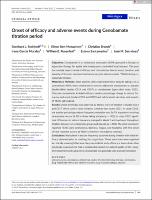| dc.contributor | Vall d'Hebron Barcelona Hospital Campus |
| dc.contributor.author | Steinhoff, Bernhard |
| dc.contributor.author | Ben-Menachem, Elinor |
| dc.contributor.author | Brandt, Christian |
| dc.contributor.author | García Morales, Irene |
| dc.contributor.author | Rosenfeld, William |
| dc.contributor.author | Santamarina Pérez, Estevo |
| dc.contributor.author | Serratosa, José M. |
| dc.date.accessioned | 2022-09-09T12:55:28Z |
| dc.date.available | 2022-09-09T12:55:28Z |
| dc.date.issued | 2022-09 |
| dc.identifier.citation | Steinhoff BJ, Ben-Menachem E, Brandt C, García Morales I, Rosenfeld WE, Santamarina E, et al. Onset of efficacy and adverse events during Cenobamate titration period. Acta Neurol Scand. 2022 Sep;146(3):265–75. |
| dc.identifier.issn | 1600-0404 |
| dc.identifier.uri | https://hdl.handle.net/11351/8121 |
| dc.description | Cenobamate; Drug-resistant epilepsy; Seizures |
| dc.description.abstract | Objectives
Cenobamate is an antiseizure medication (ASM) approved in Europe as adjunctive therapy for adults with inadequately controlled focal seizures. This post hoc analysis reports onset of efficacy and characterizes time to onset, duration, and severity of the most common treatment-emergent adverse events (TEAEs) during cenobamate titration.
Materials & Methods
Adult patients with uncontrolled focal seizures taking 1 to 3 concomitant ASMs were randomized to receive adjunctive cenobamate or placebo (double-blind studies C013 and C017) or cenobamate (open-label study C021). Outcome assessments included efficacy (median percentage change in seizure frequency and onset [studies C013 and C017]) and safety (onset, duration, and severity of TEAEs [all studies]).
Results
Onset of efficacy was observed by Weeks 1 to 4 of titration in studies C013 and C017 which used a faster titration schedule than study CO21. In study C013, the median percentage seizure frequency reduction was 36.7% in patients receiving cenobamate versus 16.3% in those taking placebo (p = .002); in study C017, significant differences in seizure frequency emerged in Week 1 and continued throughout titration between all cenobamate groups and placebo (p < .001). The most commonly reported TEAEs were somnolence, dizziness, fatigue, and headache, with first onset of each reported as early as Week 1; however, the majority resolved.
Conclusions
Reductions in seizure frequency occurred during titration with initial efficacy observed prior to reaching the target dose. These reductions were regarded as clinically meaningful because they may indicate early efficacy at lower doses than previously expected and had a considerable impact on patient quality of life. Long-term treatment with adjunctive cenobamate was generally safe and well-tolerated. |
| dc.language.iso | eng |
| dc.publisher | Wiley |
| dc.relation.ispartofseries | Acta Neurologica Scandinavica;146(3) |
| dc.rights | Attribution-NonCommercial 4.0 International |
| dc.rights.uri | http://creativecommons.org/licenses/by-nc/4.0/ |
| dc.source | Scientia |
| dc.subject | Epilèpsia - Tractament |
| dc.subject | Avaluació de resultats (Assistència sanitària) |
| dc.subject | Anticonvulsius - Efectes secundaris |
| dc.subject.mesh | Anticonvulsants |
| dc.subject.mesh | /adverse effects |
| dc.subject.mesh | Epilepsy |
| dc.subject.mesh | Treatment Outcome |
| dc.title | Onset of efficacy and adverse events during Cenobamate titration period |
| dc.type | info:eu-repo/semantics/article |
| dc.identifier.doi | 10.1111/ane.13659 |
| dc.subject.decs | anticonvulsivantes |
| dc.subject.decs | /efectos adversos |
| dc.subject.decs | epilepsia |
| dc.subject.decs | resultado del tratamiento |
| dc.relation.publishversion | https://doi.org/10.1111/ane.13659 |
| dc.type.version | info:eu-repo/semantics/publishedVersion |
| dc.audience | Professionals |
| dc.contributor.organismes | Institut Català de la Salut |
| dc.contributor.authoraffiliation | [Steinhoff BJ] Department for Adults, Kork Epilepsy Center, Kehl-Kork, Germany. Department of Neurology and Clinical Neurophysiology and Medical Faculty, University of Freiburg, Freiburg, Germany. [Ben-Menachem E] Department of Clinical Neuroscience, Institute of Neuroscience and Physiology, University of Gothenburg, Gothenburg, Sweden. [Brandt C] Department of General Epileptology, Bethel Epilepsy Centre, Mara Hospital, University Hospital for Epileptology, Bielefeld, Germany. [García Morales I] Servicio de Neurología, Programa de Epilepsia, Hospital Ruber Internacional, Madrid, Spain. [Rosenfeld WE] Comprehensive Epilepsy Care Center for Children and Adults, St. Louis, Missouri, USA. [Santamarina E] Unitat d’Epilèpsia, Servei de Neurologia, Vall d'Hebron Hospital Universitari, Barcelona, Spain. [Serratosa JM] Epilepsy Unit, Department of Neurology, Fundación Jiménez Díaz, Madrid, Spain |
| dc.identifier.pmid | 35711112 |
| dc.identifier.wos | 000811891300001 |
| dc.rights.accessrights | info:eu-repo/semantics/openAccess |

